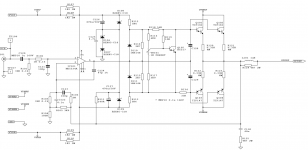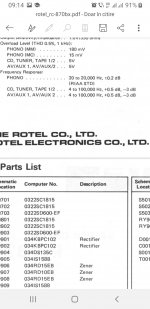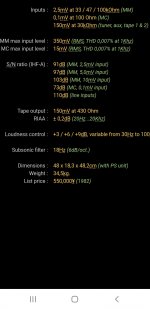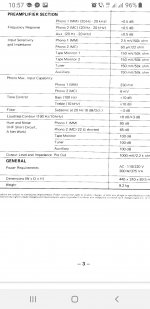Like I said, leave it alone.
Build from new a new unit using the AD797 or similar ultra low noise unit.
Good luck finding all the bits you will need.
And the cost will be high.
No need to change the op amps, quite good enough.
Build from new a new unit using the AD797 or similar ultra low noise unit.
Good luck finding all the bits you will need.
And the cost will be high.
No need to change the op amps, quite good enough.
JRC is reputed, NJM5532, some have said it is the best version.
There are many other makers, see the on line sellers' sites.
I really do not see the fuss, but everybody has their conceived notion about op amp rolling.
If the supply is within spec, and the capacitors too, nothing will be achieved by changing out 5532 to 5532, IMO.
No ties to any sellers...
Have a look at this graph:
http://www.analogue-repair.it/Immagini/Doner7.jpg
BTW, I really liked the AD8599. It is a well sounding opamp.
It will probably be true that the LT1028 doesn't improve anything but it is just a try. An amp with the LT1028 will hopefully follow.
I have an Class A Headphone amp in mind. I already simulated a voltage controlled current Headphone amp but built it using the AD8599 on a breadboard so far.
Last edited:
The opamp drives 2 darlington transistor pairs....
A fun fact is that Audio Analogue put a coupling capacitor at the apms input and didn't use a DC servo or the 5534's offset nulling capability but used no coupling caps in the preamp Bellini and a DC servo 😀
A fun fact is that Audio Analogue put a coupling capacitor at the apms input and didn't use a DC servo or the 5534's offset nulling capability but used no coupling caps in the preamp Bellini and a DC servo 😀
Attachments
Last edited:
Look at data sheets of chip amps, generally much lower, orders of magnitude lower, THD at about 90% output compared to 100% output.
Same process here in a transistor amp, so the thought that the 8 pin thingy is responsible, is very foolish, in my opinion.
The graph should represent the quality of the transistor amp, find out first its proper rating, off hand about 30 W/ch./8 ohms, I would expect for those TIP transistors.
Circuit does not mention rail voltage, which affects performance quite a lot.
Distortion should then be considered, if the op amp is safe within the rating of the power amp, then fiddling with the op amp is a wasted effort.
Same process here in a transistor amp, so the thought that the 8 pin thingy is responsible, is very foolish, in my opinion.
The graph should represent the quality of the transistor amp, find out first its proper rating, off hand about 30 W/ch./8 ohms, I would expect for those TIP transistors.
Circuit does not mention rail voltage, which affects performance quite a lot.
Distortion should then be considered, if the op amp is safe within the rating of the power amp, then fiddling with the op amp is a wasted effort.
Last edited:
I assume he swapped opamps in the same amp. So a 5534 from a different manufacturer can make a difference.
Different manufacturers have different processes too that can lead to different behaviours of the 5534.
Even opamps from the same manufacturer can be different. Analog Devices got statistics in their datasheets for some opamps.
Different manufacturers have different processes too that can lead to different behaviours of the 5534.
Even opamps from the same manufacturer can be different. Analog Devices got statistics in their datasheets for some opamps.
So Texas Instruments a bit better ?Have a look at this graph:
http://www.analogue-repair.it/Immagini/Doner7.jpg
BTW, I really liked the AD8599. It is a well sounding opamp.
It will probably be true that the LT1028 doesn't improve anything but it is just a try. An amp with the LT1028 will hopefully follow.
I have an Class A Headphone amp in mind. I already simulated a voltage controlled current Headphone amp but built it using the AD8599 on a breadboard so far.
I'm trying to get you settled on this subject as you're concerned by your Rotel rc 870 phono preamp.So in the end, is too complicated to change the 5533 or 34 and there is not real improvement ?
It all depends on the application.
In usual phono preamps using the noninverting input op amp phono preamps you look at noise , headroom preventing hard clipping and common mode distortions which you'll get a lot on dusty records.
Ne5534 noise is a good option for both mm and moderatly high output mc carts .Other opamps might have lower noise like ad745 or opa2228, but they don't allow for enough headroom as their max supply voltages are +-15...+-18v.
OPA 1642 allows for +-20v, but aren't good enough for mc carts in general and are still below the +-22v max supply of ne5534 while being found only in smd form they won't allow for too much heat disipation when hit hard nor will alow driving a lower noise low impedance riaa network.You need to leave at least +-2 v headroom for the output transistors to swing below CE saturation level so +-18 v for opa1642 might be the real limit.
OPA1652 might be a better option than opa1642 because it allows to be heatsinked through soldering so it will work colder on lower output impedance thus allowing for lower noise amd higher headroom too.
Apparently I'm not stressing out enough for the people to recognize that replacing ne5534 in phono preamps has more to do with the max supply voltage than noise, which is about the hard clipping when the output hits the rail supplies minus VCE sat which again is about the input overload capability as the preamplifier has a fixed gain , usually of 35... 40 dB or 100 x .
Input max signal can be anywhere up to 500mv when the needle hits dust particles , scratches or you just drop the needle by accident.
When that happens the input signal can increase by up to 40db which is 100x .100x 5mv means 500mv.You multiply that by another 100x , the usual phono preamp gain and you get a max output of 50 V if the mm cart is a 5mV output or 35V if the cart like shure v15type 3 is a 3.5 mV output one.That means you need at least +-37 supply...which you won't see in many solid state phono preamp , that is why tube phono preamps are the best.Luxman cl34 allows 10...15V input signal as it's supplied at 390V and also has very natural compressing characteristic as tubes usually have.
The highest supplied solid state preamps used discrete transistors supplied at 90v(technics) or +-43v( found in kenwood l-02A amplifier). The kenwood allow for max 350mv input signal and is full of clamping diodes and also controlls the input stage max gm to prevent even higher output...
You'll see barely any talk about that and I'm taking the opportunity to raise this flag on every occasion because the input max overload was mentioned in every respectable phono preamp service manual for a reason.
The standard max input for mid level phono preamplifiers was deemed to be no less than 250mV by Hitachi when they launched their op amps that can be supplied at +-30...35v.Mitsubishi had their
+-25v supplied op amps for phono and Nec had +-26....30 v supplied op amps for that job and they thought mainly about the tone equalizer stage following the phono preamp when they devised their unity gain stable op amps working at higher supply voltages.
People forget that you might need also a tone equalizer able to deal with the phono stage output .I think Gerhardt was the one to raise that problem a while ago and we assume that's unity gain stage...not feeling too well about a tone eq stage with its own gain after the phono preamp.
You can study Fisher CA2320 which has discrete phono supplied ad +-25v followed by ha1457 op amps in the tone stack. You substract 2v for final transistors VCE , divide by 40db gain amd you get exactly 230mv max input headroom that you see in the service manual.
You'll see some of the good amplifiers of the 80' and 90's employing the tone eq in the feedback path of the power amplifier to get around this problem. Harman kardon 645vxi, marantz pm66 or kenwood ka-1000 are good examples of this option.
Unfortunately there's no low noise op amp on the market today allowing for +-30v supply.Ne5532 /34 , njm2043 and njm2114 allow for +-22v and that is all you get today...
You have attached your own Rotel spec sheet , Fisher ca2320 and the kenwood l-02a spec sheet where they clearly mentioned the input overload and the input sensitivity as they are correlated and depend on supply rails and VCE sat.Apparently the mc input max overload in kenwood is identical with the one in Rotel, but it's not because that is also correlated to the input impedance for the mc cart .
Your Rotel rc 870 is different from most phono preamps as it has two stages , one linear noniverting one followed by the equalized riaa inverting stage.Ne5534 works superbely in inverted mode while his common mode distortions in noinverting mode aren't that great as today's op amps using cascodes in the input.I'd say your Rotel as a few other preamps using that topology is on a middle level doing everything it can to utilize ne5534 in the vest interest of the user. There's only one other way of wisely utilizing ne5534 and that's by putting it inside a Taylor phono preamp where the common mode distortions are prevented by showing the same input impedance to both op amp inputs as the mm cartridge is included in the feedback path.I had a try with opa 2228 on that subject which allowed me to scrap the input transistors in the past, but the headroom allowed by max +-18v supplies of the opa2228 is still not enough for preventing hard clipping in Taylor's topology and while its sound on clean vinyls is superb, dusty records sound like hell...
I'm still claiming that there's no best phono preamp without an effective compressor or compressing technique taking care of the signal.
Tube phono preamps are still king!
Attachments
That bias circuit is .... adventurous.The opamp drives 2 darlington transistor pairs....
A fun fact is that Audio Analogue put a coupling capacitor at the apms input and didn't use a DC servo or the 5534's offset nulling capability but used no coupling caps in the preamp Bellini and a DC servo 😀
Jan
Because they used a darlington pair for the bias spreader or why?That bias circuit is .... adventurous.
Jan
No they did make the best version of the NE5534.
It took a while but better opamps exist today. As in better specs, higher output current etc. so measurable properties.
It took a while but better opamps exist today. As in better specs, higher output current etc. so measurable properties.
There are only 2 current manufacturers
onsemi and TI , which one is better ?
My current preamp has signetic, should I replaced with Ti or Onsemi ?
onsemi and TI , which one is better ?
My current preamp has signetic, should I replaced with Ti or Onsemi ?
It is a difficult language with respect to precision but I managed. You already have one of the better/best versions.
Sorry my preamp is from 1987, it has 5 5534 by signetic, I was under the impresion that newer 5534 are better
Maybe you should give more details which preamp exactly and show a schematic. Possibly another modern opamp could find its place in it.
Is a Rotel RC-870BX and there is nothing better than the original op-amps
maybe there is? too many modifications
https://www.hifiengine.com/manual_library/rotel/rc-870bx.shtml
maybe there is? too many modifications
https://www.hifiengine.com/manual_library/rotel/rc-870bx.shtml
Attachments
Upgrade to RC-980BX. Had one of these every few years and they were very good and simple circuits that could be modded to excellent results.
Only 1 opamp per channel if I remember correctly (and a good one too). Less worries.
Only 1 opamp per channel if I remember correctly (and a good one too). Less worries.
- Home
- Amplifiers
- Solid State
- NE5534N best quality replacement?



